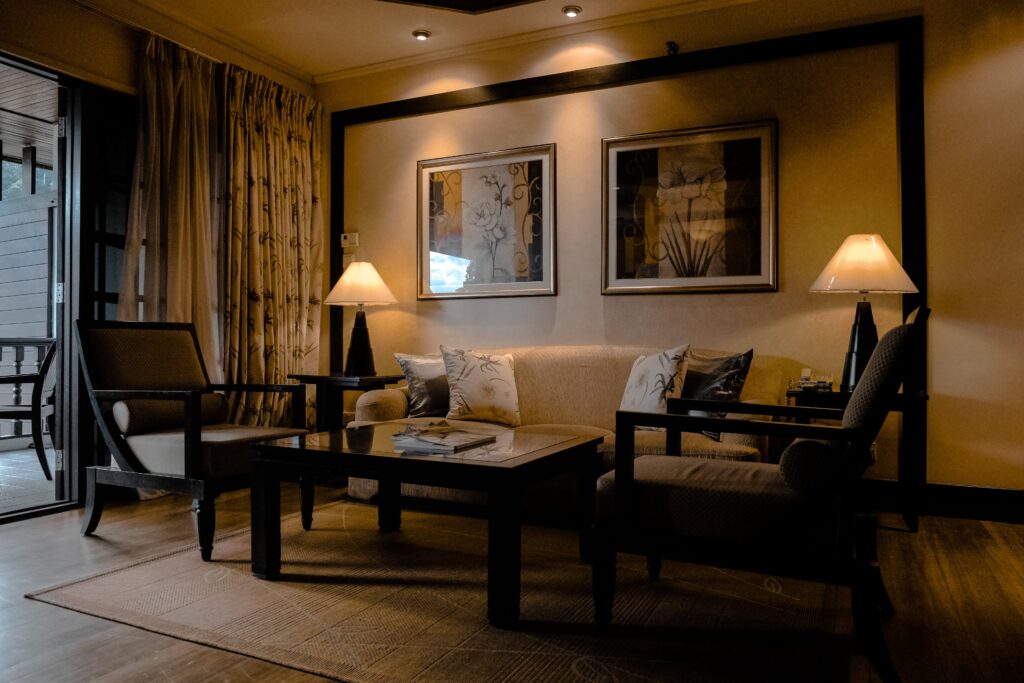Lighting is not just about illuminating a room; it’s about creating an atmosphere, adding depth, and invoking a sense of warmth and welcome. Especially in a living room, where we entertain guests, unwind after a long day, or curl up with a good book, the right lighting can transform the space. In this guide, we’ll explore how layered lighting can revolutionize your living room, turning it into a cozy haven of light and comfort.
Contents
- 1 Understanding Layered Lighting
- 2 Playing with Color Temperature
- 3 Dimmers: Your Best Friend
- 4 Mix and Match Styles
- 5 Utilize Natural Light
- 6 Creating Focal Points with Light
- 7 Play with Shadows
- 8 Layering for Small Spaces
- 9 Don’t Forget the Corners
- 10 The Art of Lampshades
- 11 Incorporate Reflective Surfaces
- 12 Be Energy Efficient
- 13 Personalize Your Space
Understanding Layered Lighting
Layered lighting is all about balance. It combines various types of light sources at different levels within the space to create a vibrant and dynamic environment. The key layers to consider are ambient, task, and accent lighting. Each layer serves its unique purpose, and when combined, they create a harmonious and welcoming atmosphere.
Ambient Lighting: The Foundation
Ambient lighting, also known as general lighting, provides overall illumination to a room. It’s the foundational layer that ensures you can move around safely and comfortably. Ceiling fixtures, chandeliers, or recessed lights are great for ambient lighting. They set the stage, but they’re just the beginning.
Task Lighting: Functional and Focused
Task lighting is all about functionality. It’s designed to help you perform specific tasks like reading, writing, or crafting. Floor lamps next to a cozy chair or table lamps on side tables are perfect for this. They not only add functionality but also contribute to the room’s aesthetic appeal.
Accent Lighting: Adding Drama and Focus
Accent lighting is the final touch that can really make your living room pop. It’s used to highlight architectural features, artwork, or key pieces of furniture. It adds depth and dimension to the room. Wall sconces, spotlights, or LED strip lighting can be used to create this effect.
Playing with Color Temperature
Color temperature plays a crucial role in setting the mood. Warmer tones, like soft whites or yellows, create a cozy and inviting atmosphere, perfect for relaxing. Cooler tones, on the other hand, have a more energizing effect. Choose LED bulbs that allow you to adjust the color temperature to suit different moods and times of the day.
Dimmers: Your Best Friend
Dimmers are a must in any living room lighting plan. They allow you to adjust the light intensity based on the time of day or the ambiance you want to create. They’re also great for energy efficiency. Imagine dimming the lights for a movie night or brightening them for a lively family gathering.
Mix and Match Styles
Don’t be afraid to mix different styles and types of light fixtures. A sleek, modern floor lamp can look stunning next to a traditional, plush sofa. Mixing styles adds character and depth to your living room. It’s all about creating a space that reflects your personal style.
Utilize Natural Light
While discussing artificial lighting, let’s not forget natural light. During the day, make the most of the sunlight. Sheer curtains can help diffuse light, filling the room with a soft, natural glow. During the evening, mirror the effect with your ambient lighting.
Creating Focal Points with Light
Use lighting to create focal points in your living room. A striking pendant light over a coffee table can draw the eye, while accent lights can be used to showcase artwork or a beautiful fireplace. Lighting can be a guide, subtly leading the gaze around the room.
Play with Shadows
Lighting isn’t just about the light; it’s also about the shadows. Playing with shadows can add a sense of mystery and drama to your living room. Use directional lighting to cast intriguing shadows on walls or ceilings, adding an artistic touch to the space.
Layering for Small Spaces
If your living room is on the smaller side, layering is still key. Use wall sconces to save floor space. A well-placed mirror can reflect light around the room, making it feel brighter and more spacious.
Don’t Forget the Corners
Dark corners can make a room feel smaller and less inviting. A tall floor lamp or a strategically placed table lamp can illuminate these areas, making the room feel more expansive and welcoming.
The Art of Lampshades
Lampshades are not just decorative elements; they influence how light is dispersed throughout the room. Translucent shades provide a soft, diffused light, ideal for a relaxing ambiance. Darker or opaque shades focus light downward, creating a more intimate atmosphere.
Incorporate Reflective Surfaces
Incorporate reflective surfaces like mirrors, glass-top tables, or metallic fixtures to maximize the effect of your lighting. These surfaces bounce light around the room, adding to the overall brightness and sense of space.
Be Energy Efficient
Opt for LED bulbs wherever possible. They are more energy-efficient and have a longer lifespan than traditional bulbs. This means they’re not just good for your wallet, but also for the environment.
Personalize Your Space
Finally, personalize your space with unique lighting choices. A quirky table lamp, a vintage chandelier, or handmade lampshades can add a touch of personality and make the space truly yours.
Layered lighting is about creating a symphony of light that enhances the beauty and functionality of your living room. By combining different types of lighting, playing with color temperatures, and adding personal touches, you can transform your living room into a warm, inviting, and dynamic space. Remember, in the world of lighting, balance is key. So, light up your living room and enjoy the depth, warmth, and ambiance that layered lighting brings.

